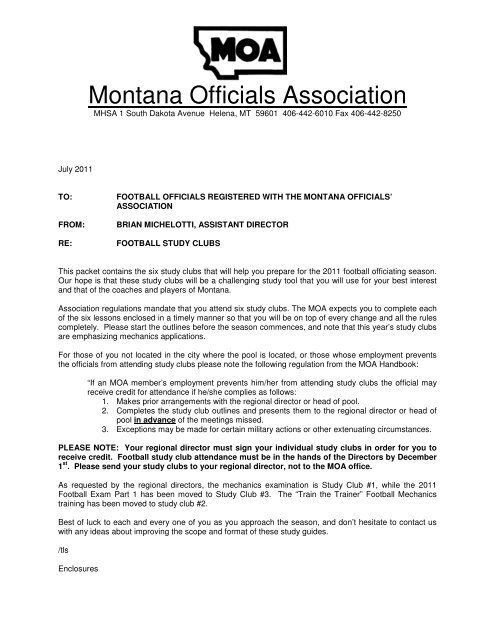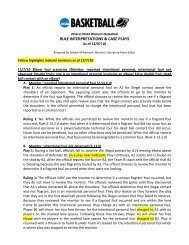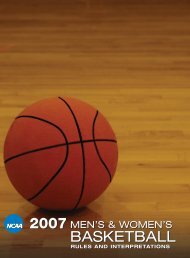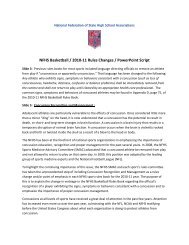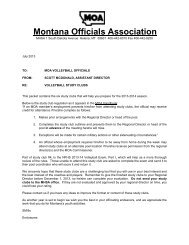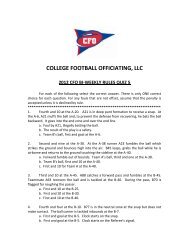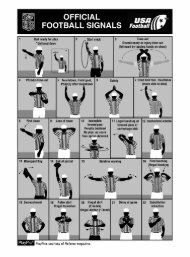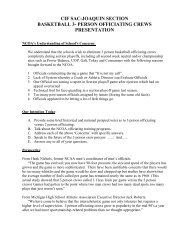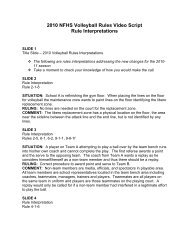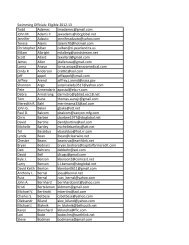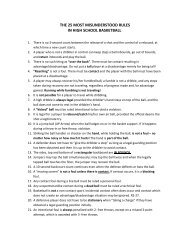Montana Officials Association - MOA - ArbiterSports
Montana Officials Association - MOA - ArbiterSports
Montana Officials Association - MOA - ArbiterSports
You also want an ePaper? Increase the reach of your titles
YUMPU automatically turns print PDFs into web optimized ePapers that Google loves.
<strong>Montana</strong> <strong>Officials</strong> <strong>Association</strong>MHSA 1 South Dakota Avenue Helena, MT 59601 406-442-6010 Fax 406-442-8250July 2011TO:FROM:RE:FOOTBALL OFFICIALS REGISTERED WITH THE MONTANA OFFICIALS’ASSOCIATIONBRIAN MICHELOTTI, ASSISTANT DIRECTORFOOTBALL STUDY CLUBSThis packet contains the six study clubs that will help you prepare for the 2011 football officiating season.Our hope is that these study clubs will be a challenging study tool that you will use for your best interestand that of the coaches and players of <strong>Montana</strong>.<strong>Association</strong> regulations mandate that you attend six study clubs. The <strong>MOA</strong> expects you to complete eachof the six lessons enclosed in a timely manner so that you will be on top of every change and all the rulescompletely. Please start the outlines before the season commences, and note that this year’s study clubsare emphasizing mechanics applications.For those of you not located in the city where the pool is located, or those whose employment preventsthe officials from attending study clubs please note the following regulation from the <strong>MOA</strong> Handbook:“If an <strong>MOA</strong> member’s employment prevents him/her from attending study clubs the official mayreceive credit for attendance if he/she complies as follows:1. Makes prior arrangements with the regional director or head of pool.2. Completes the study club outlines and presents them to the regional director or head ofpool in advance of the meetings missed.3. Exceptions may be made for certain military actions or other extenuating circumstances.PLEASE NOTE: Your regional director must sign your individual study clubs in order for you toreceive credit. Football study club attendance must be in the hands of the Directors by December1 st . Please send your study clubs to your regional director, not to the <strong>MOA</strong> office.As requested by the regional directors, the mechanics examination is Study Club #1, while the 2011Football Exam Part 1 has been moved to Study Club #3. The “Train the Trainer” Football Mechanicstraining has been moved to study club #2.Best of luck to each and every one of you as you approach the season, and don’t hesitate to contact uswith any ideas about improving the scope and format of these study guides./tlsEnclosures
MONTANA OFFICIALS’ ASSOCIATIONFOOTBALL STUDY CLUBSLESSON #12011-12NAME ____________________________________________________________________________CLUB ________________________________________________ DATE ______________________I. Preferably use before the season’s first game:A. Review your <strong>MOA</strong> Handbook. Review and discuss the following changes for this year that applyto general <strong>MOA</strong> information and football:<strong>MOA</strong> Handbook Changes and reminders for 2011-12 are as follows:1. Mileage has increased from .50 cents per mile last year to .51 cents per mile this year. Perdiem for each official, including the driver, remains at .08 cents per mile. So, the driver, for aregular season match, would receive .59 cents per mile while the rider official would receive.08 cents per mile.2. Pink whistles may be used by officials at contests designated as breast cancer awarenessevents. Any other uniform modifications for the purpose of supporting a charitablefundraising event must be approved in advance by the <strong>MOA</strong> Commissioner.3. Language has been added to the <strong>MOA</strong> Handbook to allow officials whose employmentrequires them to be away from home during the week to attend study clubs at an alternatepool location with the permission of both the regional director and the <strong>MOA</strong> Commissioner.4. When football crews wear the “approved” black pants, black socks are required.5. <strong>MOA</strong> exams are now offered exclusively online. All are open book exams. The passingpercentage for apprentice and certified remain at 60% and 80% respectively, and the passingpercentage for master has increased from 70% to 85%. Note: The deadline for requestingan upgrade has been reduced from twenty (20) days to seven (7) days prior to the opening ofthe exam.6. For clarification, the football coin toss must occur three (3) minutes prior to the game. A pregameprocedure guide can be found on the MHSA football page at www.mhsa.org.7. Mercy Rule – If a score occurs and the point differential is still greater than 35 in any Class A,B or C (8 and 6 player) football game, the clock will stop between the score and the ensuingfree kick.The MHSA Executive Board and the <strong>MOA</strong> Regional Directors have approved the followingamendments, replacements and additions to the MHSA/<strong>MOA</strong> Handbook:1. The MHSA Board approved the following addition to Section (34), D.1. (MHSA Crowd Controlpolicy): Special attention must be given to the supervision of student cheeringsections including having an administrator present near the vicinity of the studentcheering section for home and post season contests to assist with crowd control.
2. Approved requiring Cultural Diversity Training for all MHSA member school coaches andadministrators and for all <strong>MOA</strong> officials. The format for the training, including locations etc.will be announced in the near future.3. Approved a mandate that assistant and school approved volunteer coaches must also viewthe MHSA mandatory on-line rules clinic for their respective sports. The requirement forhead coaches to view the clinic was previously established.4. Under Coaching Staff on page 56, add to #7— Respect the official’s judgment andinterpretation of the rules. Question them with respect and dignity only when the gamerules permit. After a contest, questions concerning an official’s call, mechanics, orprocedural duties should be addressed through the respective official’s pool leader,the <strong>MOA</strong> Regional Director or the <strong>MOA</strong> office. A report form for unusual situations islocated on the MHSA website.5. Under Athletic Director on page 57 — add to # 7 — Make sure that the officials and theirdressing area are taken care of in the proper manner. Questions concerning an official’scall, mechanics, or procedural duties should be addressed through the respectiveofficial’s pool leader, the <strong>MOA</strong> Regional Director or the <strong>MOA</strong> office. A report form forunusual situations is located on the MHSA website.6. Under XVII, <strong>MOA</strong> Code of Ethics on page 291 — add to letter L — I will not approachcoaches or athletic directors, personally or by mail, relative to assignments or ratingsor in regard to game calls, mechanics or procedural duties. Those questions should beinitially addressed through the pool leader, <strong>MOA</strong> Regional Director or the <strong>MOA</strong> office.II. Review and discuss all of the following new NFHS rule changes for 2011:1-1-8 Administrative duties of game officials clarified.Comment from NFHS Rules Book - The committee clarified that administrative duties for gameofficials may need to continue after the game to document actions which occur during the game. Thisrevision illustrates the difference between the game officials’ jurisdiction during the game and otheradministrative responsibilities such as submitting specific reports after the game. In addition, thecommittee clarified that State <strong>Association</strong>s may continue to develop and implement policies that allowfor review of unusual incidents that occur while the game officials have jurisdiction or after the game.1-5-1c(4)Thigh guard standard revised.Comment from NFHS Rules Book - The committee determined that the thigh guard specificationsregarding composition, compression resistance and required thickness of the outside and insidesurfaces were not necessarily applicable to newer technologies being used in current production. Therequirements for wearing thigh guards and that the guards be unaltered from the manufacturer’soriginal design/production remain part of the rule.1-5-3c(3) (NEW) Eye shade restrictions adopted.Comment from NFHS Rules Book - The committee adopted new restrictions in response toincreasing use of “face painting” and the placement of words and other symbols within eye shade(grease or no-glare strips or stickers). In recent years, players were applying materials in situationswhere it was not necessary for game conditions. In other cases, it appeared that some use of eyeshade and other face paint was intended to draw attention to the individual player. Under the revision,if a player uses eye shade, it must be applied using a single solid stroke under each eye. Thecommittee’s intent was that eye shade be located below and within the width of the eye socket andnot extend below the cheek bone. No words, numbers, logos, or other symbols of any type may beincluded within the eye shade.
2-3-8 Chop block redefined.Comment from NFHS Rules Book - The definition of a chop block was modified by the committee.The revised language specifies that any combination block where one block is high (above the knee)and one block is low (at or below the knees) constitutes a chop block, with or without a delay betweenthe blocks. The rule change also stipulates that a low-low combination block is no longer a chopblock.2-6-1, 2; 3-5-8 Injury timeout conferences restricted to outside nine-yard marks.Comment from NFHS Rules Book - With two changes, the committee labeled the two types ofauthorized team conferences (“Outside Nine Yard Mark Conference” and “Between Nine Yard MarkConference”). In addition, the committee specified that when an injury occurs and the referee grantsan authorized conference, it must be an “Outside Nine Yard Mark Conference”. This will give medicalpersonnel time and space to address the injured player.3-5-10a-cProvisions for removal of injured players standardized.Comment from NFHS Rules Book - The committee standardized the rules regarding the replacementof apparently injured players (3-5-10a), players who exhibit concussion signs and symptoms (3-5-10b) and players who are bleeding or have blood on himself or the uniform (3-5-10c). Playersremoved in any of these situations must leave the game for at least one down (unless halftime or theovertime intermission occurs) and comply with the remainder of the applicable rule. The rule alsostipulates that the time-out taken in such circumstances constitutes an officials’ time-out.9-4-3kHorse collar penalty enforcement clarified.Comment from NFHS Rules Book - The committee stipulated that all horse collar fouls are to betreated as live ball fouls.9-4 PENALTY Enforcement spot for roughing the passer revised.Comment from NFHS Rules Book - Penalties for roughing the passer are now enforced from thedead ball spot when there is no change of team possession and the dead-ball spot is beyond the lineof scrimmage provided A maintains possession.9-6-2 Illegal participation revised.Comment from NFHS Rules Book - With this change, the rule regarding illegal participation now hasbeen extended to apply to a player who intentionally goes out of bounds and, while out of bounds,affects the play, touches the ball or otherwise participates. Action of this type would now constituteillegal participation and be penalized 15 yards from the basic spot.9-8-1g(3) (NEW) Penalty added for violations of Rule 3-2-2.Comment from NFHS Rules Book - This change stipulates that an unsportsmanlike penalty will beassessed to the head coach for violation of the restrictions contained in Rule 3-2-2.9-8-6-player Rules Removal of point differential note.Comment from NFHS Rules Book - This change removes the provision in the Nine-, Eight- and Sixplayerrules differences regarding point differential as state association running clock/mercy ruleswould apply per Rule 3-1-2.2011 Editorial Changes1-1-8, 9; 1-2-1 NOTE; 1-2-3b NOTE 2; 1-4-1; 1-5-1b(6)e and NOTE; 1-5-1b(7)e and NOTE; 1-5-1c(3, 5);1-5-1e; 1-5-2a-c; 1-5-3a-c; 1-6-1, NOTE; 1-6-2 NOTE; 1-7 NOTE (NEW); Table 1-7; 2-16-2f; 2-20-1a-b; 2-26-4; 2-32-5a; 2-33-2; 2-41-9a;3-1-5; 3-2-2; 3-3-6; 3-5-2c; 3-5-4; 3-5-7; 3-5-10a-c; 3-7-1; 5-1-3f; 6-1-4; 7-5-2ce;7-5 PENALTY; Table 8-1; 8-2-2, 3; Table 9-3-6; 9-4-2; 9-4-8; 9-4 PENALTY; 9-5-1; 9-5-1f-g; 9-8-1;9-8-1b-d; 9-8-1g(2); 9-8-1l; 9-8-1 PENALTY; 10-1-2; 10-5-5; FOOTBALL PENALTY ENFORCEMENT;FUNDAMENTALS – III-1, IX-1, X-3;RESOLVING TIED GAMES – 5-3-1; NINE-, EIGHT- AND SIX-PLAYER RULES DIFFERENCES – Rule 2, Rule 7 (Six-Player); Penalty Summary.
2011 Point of EmphasisConcussions, Contact Both to and With the Helmet, and Helmet Technology and Proper Helmet FittingSee the FHS rule book for more information on this 2011 Point of Emphasis -III. Review and discuss the articles listed in the Football Preseason Guide 2011 which was included inyour football packet. (Please review the plays and rulings for each rule change area if they areprovided).IV. Answer and discuss all questions on the 2011 Officiating Mechanics Examination. We recommendthat you complete it orally as a group. Please contact the office if you note any errors. The <strong>MOA</strong>expects all officials to “go by the book” – the NFHS Football <strong>Officials</strong>’ Manual.OUTLINE MUST BE SIGNED BY ALL PRESENT AND SENT TO YOUR REGIONAL DIRECTOR BYDECEMBER 1, 2011
2010 and 2011 FOOTBALL FIVE-OFFICIAL OFFICIATING MECHANICS EXAMINATIONCopyrighted and Published in 2010 by the National Federation of State High School <strong>Association</strong>sNOTE: In the exam situations, A--refers to the offensive team and B--refers to their opponents thedefensive team. K--refers to the -kicking team and R--refers to the receiving team. A1, B1, K1 and R1 areplayers of these teams. If team possession changes during the down, each team retains its identity. Inkicking situations, it is not during a try and no fair-catch signal has been given unless specified. Unlessstated, acts occur while: the ball is inbounds; a forward pass is legal; any out-of-bounds is between thegoal lines. Line means scrimmage line. Reference to a foul is to a player foul which is notunsportsmanlike. There is no foul or change of possession, unless it is mentioned, and penalties areconsidered accepted for enforcement. The questions in this examination are to be answered on the basisof a five-official crew of officials, unless a four-official crew is specifically designated.1. The officials’ appearance does not affect the attitude of coaches, players and fans.2. The penalty marker shall be a light gold flag (25 inches x 25 inches) with a middle pouchweighted with sand or beans, etc.3. By state association adoption, foul weather, full-length, lined black pants with a single 1¼-inchwhite stripe down each leg may be worn in place of the traditional knickers if worn by the entirecrew.4. Football officials must have a football sense which supersedes the technical application of therules so that the game goes smoothly.5. Before the game, the linesman should accompany the referee as he visits with each head coach,and examine and rule on any player equipment about which the coach has a question of legality.6. In the pregame conference, the back judge should review starting time and be sure an auxiliarystopwatch, which accumulated time, is available.7. The line judge should check the line-to-gain equipment and meet the crew before the game.8. <strong>Officials</strong> should arrive at the site of the game at least 1½ hours before the scheduled game time.9. The referee is authorized to correct an obvious error in timing if discovered prior to second liveball following an error unless the period has officially ended.10. The line judge notifies all other officials when period-shortening procedures are in effect.11. The referee shall coordinate the inspection of playing field and pylons.12. The line judge should take care of the game ball after approval by the referee.13. When using a field microphone, the referee should announce the number of the player whocommitted the foul.14. The referee’s use of a field microphone adds another dimension to communication – a positivedimension when used properly.15. In presence of the line judge, the referee shall instruct the visiting captain to give “heads” or “tails”choice before coin toss.16. At the conclusion of the coin-toss procedures and after the captains have been dismissed, onlythe umpire and linesman move together for final instructions from the referee.17. If the winner of the coin toss defers, the referee will step toward the press box and give the tossoption deferred signal twice.18. Back judge should bring approved game ball from each team to the coin toss.19. After the ball is spotted, the umpire should stand over the ball until the referee marks it ready forplay.20. It is not mandatory that any coach receiving two unsportsmanlike fouls carrying 15-yard penaltiesvacate the stadium area.
21. The line judge or linesman should notify the coach on his side as to the reason fordisqualification.22. The referee is the only official who is to notify the opposing coach of a disqualification.23. All officials must consistently administer and enforce team-box and coaches’ area restrictions.24. If a team-personnel altercation is in an official’s area, he should attempt to stop initialconfrontation.25. In controlling team-personnel altercations, the linesman and the line judge should alert the coachon their side to keep all team personnel off of the playing area.26. The umpire is the official who will indicate the end of the fourth period.27. After a score or try, prior to the free kick, the line judge, while at the hash marks, counts K playersand identifies the free-kick line for the receiving team.28. After a score or try, prior to the free kick, the linesman does not need to check with the line-togaincrew for questions and positions.29. After a score or try, prior to the free kick, all officials need to encourage both teams to take freekickpositions quickly.30. For all officials, the bean bag is to serve as an aid to enforcement and is the absolute referencepoint.31. The penalty marker should be tucked out of sight for all officials.32. Discretion, officiating position and game situation should determine whether the penalty marker isdropped or tossed following an infraction.33. Before the kick on the kickoff, the referee should be on R’s 10-yard line on linesman’s side justoutside hash marks.34. Before the kick on the kickoff, the referee will count R players.35. On a kickoff, the referee, on a deep kick, shall retreat to the 5-yard line to rule on a touchback.36. The referee, on a kick down the middle on a kickoff, should pick up the runner and follow him untilreleasing to the covering official.37. The umpire, on a kickoff, if a short kick is anticipated, should be positioned on K’s free-kick line.38. The umpire, on a kickoff, before the kick, holds arm above his head to indicate he is ready.39. The umpire, on a kickoff, on a kick to his side, signals clock to start when kick is touched, only ifthe ball is even or upfield from the umpire.40. Before the kick on the kickoff, the umpire should count K players.41. The linesman, on a kickoff, before the kick, should monitor bench area.42. The linesman, on a kickoff, should maintain position-enabling coverage of the middle of the field.43. The linesman, on a kickoff, on a kick to the opposite side of the field, should observe action ofother players in vicinity of kicker.44. The linesman should move cautiously with play along the sideline on a kick to the opposite side ofthe field on a kickoff.45. The line judge, on a kickoff, should watch for any infractions involving K’s free-kick line.46. The line judge, on a kickoff, after kick, watches initial blocks in his area.47. After a kick on a kickoff, the line judge should be alert for first touching, and should mark spot withpenalty marker.48. After a kick on a kickoff, the line judge should be in position to take over coverage of the runner inhis area on long return.49. The back judge’s position, on a kickoff before the kick, is on K’s free-kick line in side zone tomonitor bench area and assist kicking team in getting into position.50. The back judge, on a kickoff, should count R players.51. The back judge, on a kickoff, should be in position to take over coverage of the runner in his areaon a long return.
52. Before the kick on the kickoff, if the ball falls or blows off the tee, the back judge should soundwhistle to prevent action.53. The referee should give the game ball to the line judge between halves.54. All officials should leave the field together between halves.55. The umpire should escort the captain to center of field with the linesman between halves.56. The back judge should secure the game ball, hand it to the kicker, and instruct him to wait forreferee’s signal before he kicks.57. The line judge keeps time during intermission.58. All officials should return to the field at least five minutes before second half is to begin.59. Between halves, all officials should discuss overtime procedure if applicable.60. Between periods, the referee quickly takes the ball to the corresponding point on other half of thefield and reverses directions.61. Between periods, the umpire will check number of down and distance to gain.62. The linesman, between periods, will reverse ends of the line-to-gain indicator and two crewmen.63. Between periods, the line judge and back judge will check team box and huddle areas forappropriate conference procedure as during charged time-out.64. During an injury time-out, the back judge will summon appropriate health-care professional(s)and/or coaches on field.65. During an injury time-out, the linesman makes sure summoned appropriate health-careprofessional(s) and/or coaches are not on the field for coaching purposes.66. The referee will attempt to keep players a significant distance away from the seriously injuredplayer(s) during an injury time-out.67. When time expires and ball becomes dead at the end of the period, the umpire will sound whistleand repeat time-out signal twice.68. If the field clock is used and if time expires prior to the snap, the referee will sound his whistle toprevent snap, if possible.69. When the field clock is not used, the back judge will notify the referee approximately four minutesbefore end of second and fourth periods.70. If the ball is snapped immediately after time has expired at the end of the period, the linesman willsound his whistle loud and long.71. During a time-out, the umpire will observe Team A until the referee is ready to start play.72. All officials, during a time-out, should confirm number of remaining time-outs.73. The back judge, during a time-out, should time 60-second interval and notify referee at 45seconds and again when 60-second interval expires.74. During a time-out, the referee should maintain position over ball.75. The line judge, during a time-out, should check number of time-outs remaining for each team.76. During a time-out, the referee will inform each team’s huddle of down and time remaining inperiod.77. When measuring for a first down, the line judge will place foot just behind yard line where clip isto be placed to align linesman so that chains are parallel to sidelines.78. The umpire, when measuring for a first down, will rotate the ball so long axis is parallel to sideline.79. When measuring for a first down, the back judge will take forward indicator from crewman atplace of measurement.80. The referee will mark foremost point of ball for down-marker operator on all first downs.81. When measuring for a first down, the referee will spot the ball at the proper place whenmeasurement is completed.82. In administering penalties, the umpire will make note of enforcement spot for penalty.83. All officials, in administering penalties, will record unsportsmanlike penalties.84. The umpire will assist in relaying foul information to appropriate sideline.
85. The referee should be ready to have line-to-gain equipment moved after penalty administration.86. When there is a double foul, the referee will signal each foul, facing the press box.87. After a safety, try or field goal, the back judge will begin timing one-minute interval after thereferee signals score or no score.88. All officials should hustle up sidelines to free-kick position and then fill out game cards after asafety, try or field goal.89. The referee, on a running play, should move behind play toward side of field to which playadvances to cover runner if he is downed near line.90. On a running play, the linesman and line judge should check for disconcerting signals by B.91. The referee, on a running play, should assist with relay of the ball in the side zone from wingofficial to umpire.92. In an unbalanced formation, the strength of the formation is not determined by the number ofeligible receivers outside of the offensive tackles.93. If motion occurs, the strength of the formation is not determined until the snap.94. The linesman and line judge should be ready to adjust coverage if potential passer decides torun.95. The referee should be ready to rule on the direction (forward or backward) of a quick quarterbackpass.96. On a forward pass, the covering officials should observe touching or catching by an ineligibleplayer.97. The back judge should verbally alert defenders when the passer has released the ball.98. On a scrimmage kick, after the snap, the umpire should be alert to assist the referee in covering ashort or blocked kick and determining if the ball crosses neutral zone.99. Following a fair catch, the back judge needs to be sure referee knows it was a fair catch.100. Only officials who actually see a touchdown should give touchdown signal.OUTLINE MUST BE SIGNED BY ALL PRESENT AND SENT TO YOUR REGIONAL DIRECTOR BYDECEMBER 1, 2011
MONTANA OFFICIALS’ ASSOCIATIONFOOTBALL STUDY CLUBSLESSON #22011-12NAME ____________________________________________________________________________CLUB __________________________________________ DATE ____________________________Beginning with the 2008-09 school year, the Regional Directors approved the following requirement forfootball and basketball: Attendance will be required for each registered official at a certified <strong>MOA</strong>mechanics clinic or verification of training by a “Train the Trainer” representative who has attended the<strong>MOA</strong> mechanics clinic at the MCA clinic in Great Falls and who provides the training at a mandatorymechanics study club for all <strong>MOA</strong> basketball and football officials. Recertification of trainers will berequired concurrently with the printing of each new NFHS officials manual. For the first year, football andbasketball will be piloted and committees will be created to formulate mechanics clinics for soccer,softball, wrestling and volleyball.Also please note the penalty if an official does not meet this requirement, see the <strong>MOA</strong> Handbook, ArticleXXIII:C. <strong>Officials</strong> shall drop one rating classification for any of the following reasons:4. Failure to complete the mandatory rules clinic and/or mechanics clinic for their sport rendersan official ineligible for any postseason contest. The official’s rating is restored when theycomplete the next rules and/or mechanics clinic for their sport. <strong>Officials</strong> must notify the <strong>MOA</strong>office for restoration. If an official does not meet the mechanics clinic requirement, he/she willincur a rating reduction and will be ineligible to officiate in the post season.The <strong>MOA</strong> hosted a “Train the Trainer” clinic this summer in conjunction with the <strong>Montana</strong> Coaches<strong>Association</strong> (MCA) Clinic in Great Falls. A representative from each pool was invited to attend this “Trainthe Trainer” clinic. Everyone who attended the Great Falls clinic was credited with mechanics clinicattendance and they were provided with on-site training and were equipped with materials to facilitatetraining of other officials at the local level.Individuals who received mechanics training at the Great Falls <strong>MOA</strong> / MCA Clinic will utilize study club #2during the season to provide mechanics training to all officials in their pool. This will meet the mechanicsclinic requirement, which will allow officials to be eligible for the post season.Some pools decided not to send a representative to Great Falls, and these pools must bring in someonefrom another pool who attended the <strong>MOA</strong> / MCA Football Mechanics Clinic in August to be their trainer. Ifyour pool did not send a representative to the Train the Trainer” clinic, please contact the MHSA Office tohelp facilitate securing a certified trainer to provide the required mechanics information to your pool, sothey can be eligible to officiate in the post season.OUTLINE MUST BE SIGNED BY ALL PRESENT AND SENT TO YOUR REGIONAL DIRECTOR BYDECEMBER 1, 2011
MONTANA OFFICIALS’ ASSOCIATIONFOOTBALL STUDY CLUBSLESSON #32011-12NAME ____________________________________________________________________________CLUB _____________________________________ DATE __________________________________I. Recommendations for Study Club #3A. That the 2010 Football Examination Part I be taken by the pool at home or in a mannerappropriate to the pool. If taken at home we suggest answers be discussed orally as a group atthe next meeting.II. Discuss the major NFHS <strong>Officials</strong> Manual Changes for 2010 and 20111. The Five-Man Mechanics come before the Four-Man Mechanics in the NFHS Football <strong>Officials</strong>Manual.2. By state association adoption, foul weather, full length, lined black pants with a single 1 ¼ inchwhite stripe down each leg may be worn in place of the standard, all-white tapered knickers ifworn by the entire crew.3. The Back Judge shall carry two different color bean bags; one for marking the end of the kick andone for marking first touching.4. The Back Judge and Line Judge bring approved game ball from each team to the coin-toss iffootballs are being run off of both sidelines.5. The Referee’s normal starting position is moved to one that is visible to the clock operator,approximately 10- yards deep and 5-yards wide of the huddle when marking the ball ready-forplayon scrimmage downs.6. The Line Judge temporarily move to nine-yard marks (top of the numbers), as receiving team islining up for a free kick. (Four-Man Mechanics)7. The Referee’s scrimmage kick position is adjusted to 3-5 yards outside the tight end and 2-3yards behind the kicker, on line judge’s side of the field.8. If the football falls or blows off tee just prior to free kick, Back Judge sounds whistle to preventaction and moves to kicker to give instructions.9. The Back Judge assists with relay of the football in side zone from wing official to Umpire.10. The Referee’s position changed to 3-5 yards outside the tight end and 2-3 yards behind thekicker, on kicking-leg side on scrimmage kicks.11. The Back Judge’s position changed to 10-12 yards wider than and 2-3 yards behind the deepestreceiver on linesman’s side of field on scrimmage kicks.12. The Referee’s position changed to 2-3 yards to rear and 3-5 yards to side of potential kicker,facing holder and able to see holder receive the football on field goal attempts or trys.2010–2011 Manual Points of Emphasis1. Communication between official and head coach.2. Enforcement of uniform adornment rules.3. Enforcing that legal equipment is worn properly4. Identifying illegal substitutions
III. Discuss any problems, clarifications, concerns, or ideas that occurred while administering the majorrule changes from last year.A. Review and discuss all of the 2010 rule changes as follows:1-5-3a1-5-3b1, 2, Note 3Restrictions removed on penalty-marker colored pads or gloves.Illegal player equipment rule clarified.3-1-2; 1-7 Point differential rule modified for member state associations.3-2-2 Coin toss provisions revised.3-5-10bConcussion rule revised.3-7-1 Replaced players – replacement timeframe clarified.8-2-2; 8-2-3; 8-2-4(NEW); Penalty options for fouls on scoring plays expanded to include8-2-5; 10-4-5; scoring team fouls.10-5-1f; 2-41-109-4-3kHorse-collar clarified.9-4-8 (NEW) Penalty defined for unintentional contact between a nonplayerand an official in the restricted area.Nine-, Eight- andSix-player RulesOther Discussion Items:1. List 4-5 ways the bean bag is to be used.Field markings in nine-, eight- and six-player rule differencesadjusted.2. Discuss proper throwing of the penalty flag for a live-ball foul and for a dead-ball foul.3. Discuss the process of disqualifying or ejecting a coach. Who must be notified of thisejection within 48 hours?4. Discuss the guidelines for “when in question” principles would be applied.5. Review how one should carry the whistle as well as the process for sounding the whistle.What 2-3 situations would necessitate a different sounding of the whistle? Discuss theprocess when an inadvertent whistle occurs.Video –In all of your study clubs, we would strongly suggest the following video resources. These could beexcellent to use during all study clubs for visual learners and new officials. Here are three differentresources for video study:1. MHSA / NFHS Arbiter website for football – many great videos and resources for <strong>MOA</strong>football officials2. Refstripes.com - Procedure to register for this free service:• Go to “Home” and you will see different tabs, including one for “Tests / Quizzes” etc.
• It is in there that you will find the links to the Aloha Clinic videos.• This year’s videos will be loaded here.• DO NOT view the videos online as there is not enough band width for that.• Save the videos to your computer and then transfer them to a disc so you’ll havethem available to you3. Ten Topic Football Officiating DVD w/Voice Over - $15.00 including postage/handling -Order on-line; pay after you receive the DVDOrders must include:1. Name [first & last], Mailing Address, Contact Telephone Number, Email Address2. Number of DVDs @ $15.00 per DVD -Email your order to: wlemonnier@sbcglobal.netOUTLINE MUST BE SIGNED BY ALL PRESENT AND SENT TO YOUR REGIONAL DIRECTOR BYDECEMBER 1, 2011
2010 FOOTBALL RULES EXAMINATION – PART ICopyrighted and Published in 2010 by the National Federation of State High School <strong>Association</strong>sNOTE: In the exam situations, A--refers to the offensive team and B--refers to their opponents thedefensive team. K--refers to the -kicking team and R--refers to the receiving team. A1, B1, K1 and R1 areplayers of these teams. If team possession changes during the down, each team retains its identity. Inkicking situations, it is not during a try and no fair-catch signal has been given unless specified. Unlessstated, acts occur while: the ball is inbounds; a forward pass is legal; any out-of-bounds is between thegoal lines. Line means scrimmage line. Reference to a foul is to a player foul which is notunsportsmanlike. There is no foul or change of possession, unless it is mentioned, and penalties areconsidered accepted for enforcement.Rules Changes, Editorial Changes or Points of Emphasis for 20101. Penalty-marker colored gloves are legal.2. Grabbing the inside back or side collar of the shoulder pads or jersey of the runner andsubsequently pulling that opponent to the ground is a horse-collar.3. A player, nonplayer or coach may be in the restricted area when the ball is live.4. Football public-address announcers do not play a vital role in the promotion of goodsportsmanship.5. Replaced players shall leave the field within three seconds.6. Knee braces can be worn over the pants.7. By state association adoption, a point differential may be established whereby if one team hasgained the established point differential, the game shall be terminated.8. Any player who exhibits signs, symptoms or behaviors consistent with a concussion shall beimmediately removed from the game and shall not return to play until cleared by an appropriatehealth-care professional.9. An offensive player may push, pull or lift the runner to assist his forward progress.10. Beginning in 2012, gloves that may be anchored with athletic tape, and even though modified,must meet the NOCSAE test standard at the time of manufacture, unless made of an unalteredplain cloth.Authorized Conferences11. An authorized conference is permitted during the intermission between periods.12. If one coach goes to the huddle for 30 seconds, another coach may then confer for the timeremaining as long as only one coach is in the huddle at any given time.Batting13. Batting a scrimmage kick in or behind the neutral zone by R, in an effort to block the kick, is legal.14. B1 may not legally bat a ball that is in possession of A1.15. A backward pass in flight may be batted in any direction by either team.16. Batting a ball in flight may add a new force to the ball.Blocking17. A block in the back is defined as a block with contact inside the shoulders, below the helmet andabove the waist.18. A chop block is a legal block within the 6 x 8 yard free-blocking zone.19. The runner may be legally clipped.20. Any player in the free-blocking zone, at the time of the snap, may block below the waist.Dead Ball21. If the try is by kick, the ball becomes dead when it is obvious the drop kick or place kick hasfailed.22. The ball becomes dead when any loose ball is simultaneously caught or recovered by opponents.
Definitions23. The neutral zone is established after the snapper has made final adjustment of the ball.24. A forward pass has gone beyond the neutral zone if at any time during the pass, some part of theball is beyond the neutral zone.25. A foul is a rule infraction for which a penalty is prescribed.26. A down begins when the ball is marked ready-for-play.27. The line of scrimmage for each team is determined when the ball is marked ready-for-play.28. If an official is out of bounds when he is touched by a loose ball, the touching is ignored.29. Fighting is any attempt by a player or nonplayer to strike or engage a player or nonplayer in acombative manner unrelated to football.30. The succeeding spot is where the ball was last snapped or free kicked.Downs – New Series31. If a double foul occurs during a down, the number of the next down is not the same as that of thedown in which the foul occurred.32. The down is ended when the runner allows any part of his person, other than hand or foot, totouch the ground.Equipment: Game – Field33. If the field of play has a logo in the center or at any other part of the field of play, that logo shouldnot obstruct from the visibility of the required marks every five yards.34. The uprights shall extend a maximum of 10 feet above the crossbar.35. The goal-line pylons may be any color as long as they are the same color.36. <strong>Officials</strong> may use available television replay equipment to assist in making certain criticaldecisions relating to the game.37. An unofficial auxiliary down indicator may be used, but it must be operated approximately 2 yardsoutside the sideline (except in stadiums where the total playing enclosure does not permit)opposite the official line-to-gain and down indicators.38. The referee is the final judge as to the legality of the game ball.Equipment: Player39. A mouth protector must be worn and must be completely white or clear.40. The pants must cover the knee pads.41. Hip pads, tailbone protector, knee pads and thigh guards may not be altered from themanufacturer’s original design/production.42. A tinted eye shield is illegal.43. A player’s towel may have a ball-drying product applied to it that will affect the football.44. The head coach’s verification that his players are legally equipped includes a visible exteriorwarning label on the helmet regarding the risk of injury.45. Prior to the game, the umpire must check and personally verify that all player equipment is legal.46. Beginning in 2012, players of the visiting team shall wear white jerseys that have additionallimitations as to how much color may be on its jersey.Fouls47. It is legal to grasp the opponent's chin strap.48. A multiple foul is one or more live-ball fouls by each team resulting in offsetting penalties.49. The runner may use his hands or arms to ward off or push an opponent.50. It is legal for runner A1 to spear B1.51. All dead-ball fouls are enforced separately and in the order in which they occurred.52. It is defensive holding if B1 tackles A1, who is obviously not the runner.53. A live-ball foul and a dead-ball foul cannot be combined to create a double foul.54. The restrictions on players being in the team box extend from the 35-yard line to the 35-yard line.55. A nonplayer foul may influence the play in progress.56. An illegal shift is a foul at the snap.
Fundamentals – Fundamental Statements57. A kick ends as soon as R1 touches the kick.58. A disqualifying foul during the down causes the official to sound his whistle immediately.59. No series can ever start on a down other than first.60. A handed ball beyond the neutral zone is considered to be a pass.Illegal Participation61. If a substitute or replaced player influences the play, it is illegal participation.62. It is illegal substitution to have 12 or more players participating at the snap or free kick.Illegal Formation63. The players on each side of and next to the snapper may lock legs with the snapper and maystand, crouch or kneel.64. At the snap, at least eight A players shall be on their line of scrimmage.65. After the ball is marked ready-for-play, each player of A who participated in the previous downand each substitute for A must have been, momentarily, between the 9-yard marks before thesnap.66. Of the players of A who are not on their line at the snap, only one may penetrate the verticalplane through the waistline of his nearest teammate who is on his line.Passing67. It is pass interference if ineligible A1 catches a forward pass in or behind the neutral zone.68. If the ball is beyond the neutral zone when it leaves the passer’s hand on a forward pass, it is anillegal forward pass.69. Interference by B may occur beyond, in or behind the neutral zone.70. A passer is a player who either throws a forward pass or backward pass.71. During an illegal forward pass, pass eligibility restrictions do not apply.72. Touching of a forward pass by B1 causes pass interference restrictions to end and all A playersto become eligible.Penalty Enforcement73. The referee shall grant a captain’s request for time-out prior to accepting or declining a penaltywhich involves an automatic first down.74. When the same team commits a live-ball foul followed by one or more dead-ball fouls, all foulscannot be penalized.75. If two teammates participate while wearing identical numbers, the foul occurs simultaneously withthe snap.76. The penalty for roughing the snapper is 15 yards and also a first down.77. If the head coach is ejected, the game must be forfeited immediately.78. The penalty for an illegal forward pass is 10 yards and loss of down.Possession79. A simultaneous catch or recovery is a catch or recovery in which there is joint possession of a liveball by opposing players who are inbounds.80. A catch of an opponent’s fumble or pass is called a recovery.Safety81. If K1 holds R1 in K’s end zone to prevent R1 from recovering a blocked punt, it will be a safety ifR accepts the penalty.82. If B1 intercepts A’s forward pass in B’s end zone, it is a safety if he is tackled there.83. The batting of a pass, kick or fumble in flight is not considered a new force for judging whether atouchback or safety results.84. It is a safety, if R1 in an effort to block K1’s field-goal attempt, leaps high in the end zone and tipsthe ball between the uprights above the crossbar.
Scrimmage Kicks85. If a kick becomes dead in R’s end zone, it is always a safety or touchback.86. During a scrimmage kick, the kicker remains a kicker until the ball is in flight beyond the neutralzone.87. Any K player may catch or recover a scrimmage kick while it is in or behind the neutral zone andadvance, unless it is during a try.88. It is not necessary to be in a scrimmage kick formation to execute a legal scrimmage kick.Snap89. The snap ends when the ball touches the ground or any player.90. In a snap, the ball must immediately leave the hand(s) of the snapper and touch a backfieldplayer or the ground before it touches a Team A lineman.91. The snap begins when the snapper moves the ball by tilting it on end during adjustment.92. The snapper may lift the ball for lateral rotation but may not rotate the ball end-for-end or changethe location of the ball.Time-outs93. An official’s time-out can be called for unusual heat or humidity situations.94. If A1 appears injured and an official calls a time-out, A1 must leave the game for at least oneplay.95. The head coach may come onto the field and request the nearest official to grant a time-out.96. No single charged time-out shall exceed one minute.Timing97. After the ball becomes dead and it appears that the ball may have reached the line-to-gain, thecovering official shall stop the clock.98. A clock stopped during a period for an official’s time-out will start with the ready-for-play signalwith the only exception being when a free kick follows.99. During a down, if time expires for a period and a signal is sounded, the officials shall ignore thesignal.100. If a free kick is repeated due to a foul, the clock shall start when the free kick is touched, otherthan first touching by K.
MONTANA OFFICIALS’ ASSOCIATIONFOOTBALL STUDY CLUBSLESSON #42011-12NAME ____________________________________________________________________________CLUB ______________________________________________ DATE ________________________I. Preseason Guide 2011 – Great articlesIn addition to the articles that deal with the new football rule changes and rationale, the NFHSpreseason guide this year has some other excellent articles for football officials. The articles providegreat insight on many of the issues that we have had challenges in the past in <strong>Montana</strong>. Many of thetopics that have been discussed are similar to issues that have been sent out in the <strong>MOA</strong> weeklyfootball memos the past three years. Here is a summary of the articles all officials should read,review and discuss:1. Page 7 – The Mystery of Myths• Ends and backs can false start• All defensive personal fouls have an automatic first down• The original force can be changed while the ball is in the end zone2. Page 7 and 8 – Scrimmage Scrums, forward Progress and Helping the Runner3. Page 8 and 9 – The Game’s Afoot – Rules regarding Scoring Kicks4. Page 9 and 10 – One Play Multiple Flags5. Page 10-11 – Roger, Lucy and Other ‘Friends” – Article on defensive players using disconcertingacts or words6. Page 11-12 - Passing the Word – Article on <strong>Officials</strong> recognizing situations and communicatingwith other officials to better their performance during the game.7. Page 13 – The Difference Between Fumbles, Muffs8. Page 14 – This One’s Over (Or Is It?) – Article on dealing with games decided on the final play,extending periods, etc.9. Page 15 – The Ins and Outs of Substitutions –10. Page 16 - Don’t Try It – Article on trys at the end of games.11. Page 16 - Catalyst for Mistakes – problems that can occur with a chain crewThese articles provide great information for all levels of officials. Please include this information inyour rules study as the season goes on – You will see some of these references this year, and also infuture years in the <strong>MOA</strong> weekly memos.II. Read and discuss the following article – What are you doing locally to build these relationships?Have you invited local coaches to your weekly meetings? Do you have an open line ofcommunication with coaches?III. Discuss the following topics which were in the NFHS’s <strong>Officials</strong> Quarterly in regard to “WHATCOACHES WOULD LIKE OFFICIALS TO KNOW”:
Improving Relationships Between Coaches and <strong>Officials</strong>By Dr. Bill WelkerUnfortunately, more often than not, coaches and officials consider each other to be adversaries. Ithink I can offer some suggestions that may help to alleviate this uncomfortable condition between thetwo factions. Both coaches and officials can work together in closer harmony if they understand theconcerns of one another.The following is a survey taken of coaches and officials by Robert G. Hoehn, a former wrestling coachand author of several sports books. So, here they are — the eight “big wishes” of coaches and thenthe top eight desires of officials.WHAT COACHES WOULD LIKE OFFICIALS TO KNOW1. Act in a professional manner. Treat coaches and their athletes with respect.2. Thoroughly know the rules.3. Be consistent when making calls and decisions.4. Keep the athletes moving at a brisk pace.5. Be on the lookout for dangerous situations, and alert the coach when the athlete runs the risk ofinjury.6. Demonstrate a positive attitude toward athletics, not one of supreme authority. In otherwords, don’t act like gods, but stewards of the sport.7. Refrain from prejudging a coach, school or athletic team. Give everyone involved the opportunityto prove himself or herself.8. Finally, don’t cover up a mistake. Nobody expects perfection. If an error occurs, admit to it, andtry not to make the same mistake again. Also, avoid coaching an athlete at the coach’s expense.Never make a coach look foolish by correcting athletes in a condescending manner.WHAT OFFICIALS WOULD LIKE COACHES TO KNOW1. Treat officials in a polite, friendly manner. However, don’t come on like college chums meeting forthe first time in 15 years. Being too friendly creates problems when close calls go against theopposing team.2. Keep negative comments about coaches, athletes or other officials to yourself. A coach whoridicules others in front of strangers displays poor judgment and shows a lack of good sense.3. Have everything ready to go so the contest can start on time. Provide a safe and secureenvironment for officials to store their valuables.4. See to it that officials are paid on time. Either pay them on the day of the contest or mail checksout the following day. A great way to strain a relationship is to wait four or five weeks beforemailing checks.5. Refrain from discussing a previous contest and close calls. <strong>Officials</strong> must concentrate on today’smatch or game — not rethink past competitive situations in which they were involved.6. Hold conversations to a minimum. Don’t distract officials with needless chatter.7. Know the rules. Read the rules book. Study any new rules changes. Don’t waste the official’s timewith matters in which you should have known the rule.8. Approach the official with respect — and as an equal — when questioning a difficult call.In essence, coaches and officials need to be thinking on the same wavelength. This is really not toodifficult to accomplish, especially when both the coach and official follow the values of goodsportsmanship.
IV. Basic Football Principles/Fundamentals.Read the following and fill in the blank.1. A __________ ball is in player possession or is loose.2. A player in possession of a live ball is a __________.3. No foul causes __________ of the ball.4. A player cannot fumble before gaining __________.5. A down begins when the ball becomes __________ and ends when it becomes __________.6. An official’s whistle seldom __________ the ball.7. No __________-ball foul causes the ball to become __________.8. Catching is always preceded by __________ of the ball.9. A dead ball may become live only by a __________ __________ or __________ __________.10. A kick always ends as soon as any player secures __________.11. Free kick lines are always __________ yards apart.12. A scrimmage kick recovered in or behind the neutral zone may be advanced by _____ or _____.13. A forward pass interference foul can occur only beyond the __________ __________.14. The __________ penalty for any foul may be declined.15. Penalty enforcement for any dead ball, nonplayer or unsporting foul is from the __________spot.OUTLINE MUST BE SIGNED BY ALL PRESENT AND SENT TO YOUR REGIONAL DIRECTOR BYDECEMBER 1, 2011
MONTANA OFFICIALS’ ASSOCIATIONFOOTBALL STUDY CLUBSLESSON #52011-12NAME ____________________________________________________________________________CLUB ______________________________________________ DATE ________________________I. Penalty Enforcement – StudyPenalty enforcement is one of the most challenging areas to learn in high school football. Tounderstand penalty enforcements, officials must over learn the following principles. The definition ofoverlearning on the web is described as:- a concept according to which newly acquired skills should be practiced well beyond the point ofinitial mastery, leading to automaticity. Once one has overlearned a task, one's skill level is higherthan the challenge level for that task..If officials take the time to “overlearn” the following items that can be found in Rule 10 of the NFHSFootball Rules book, penalty enforcement will become much easier to understand and administer:• Review and discuss the on field procedures for administering penalties• Understand the Double and Multiple foul administrations.• What are the four fouls that cause Team A to lose the right to replay a down?• What are the four fouls by Team B that give Team A an automatic first down?• Master all of the principles of penalty enforcement including:• Types of Plays (loose ball and running plays)• Basic spots• All but one principle• Review the special enforcement provisions and especially memorize the nine fouls that havespecial enforcement provisions and options for the offended team1. Review and discuss challenging situation that you have experience in games in regard to penaltyenforcement? Share with the group specific situations.2. What times during the game will you most likely have the most complicated penaltyenforcements?3. Review the NFHS Casebook – pages 86-96 for specific examplesII. Penalty Enforcements Philosophy<strong>MOA</strong> Policy requires that all officials must follow and use the mechanics and signals that are in theNational Federation’s <strong>Officials</strong>’ Manual and adhere to all rules and regulations listed in the NFHSrules book for each sport. All officials must understand that personal interpretations of the rules havea negative impact on the game. The rules are written to provide a balance between offense anddefense, minimization of risk to participants, promotion of the sound tradition of the game andpromotion of fair play.Individual philosophies and deviations from the rules as written, negatively impact the basicfundamentals and tenets of the rules. <strong>Officials</strong> must be consistent in the application of all rules.
1. Discuss situation where you have observed officials make or not make calls because of thegame situation or player involved. Is this the correct thing to do? How should your poolhandle these situations – Discuss!2. Advantage / Disadvantage – Discuss in your pool the philosophy in regard to officiatingsituations on the field where an advantage may be gained. For instance, should you callholding on a offensive lineman only if it has an affect on the play or do you call it in allsituations?3. Could this philosophy of on advantage gained cause you problems later in the game?Discuss?III. This lesson has been prepared by Jim Corpora, a member of the PIAA Eastern Penn FootballChapter.A. AXIOMS OF FOOTBALL OFFICIATINGBelow are listed some time-tested axioms of football officiating. You may want to considerreviewing these prior to and during each season. They help prevent problems.• Do not throw your flag if there is any doubt.• Do not blow your whistle unless you personally see the ball is dead.• Do stop the clock for an apparently injured played.• Team A players are legally on the LOS.• The QB has not intentionally grounded the ball.• The block is legal, not a clip.• A departing player has left the field prior to the snap.• The ball is dead (the runner was down prior to the “fumble”).• The ball is passed and not fumbled during an attempted forward pass.• A ball was muffed rather than caught.• The ball is dead in the field of play rather than out of bounds.• The legal clipping zone was still intact.• Make the tough call if it is there.• What effect did the action have on the play?• Our job is to judge plays; it is NOT to judge players and coaches.• The only part of officiating to emphasize is your signals.• Never stand still during an entire down. It appears as though you’re lazy.• Communication, Consistency, and Common Sense.• Start each game without any grudges against teams, coaches and players.• Refer to players by their number or position. NEVER call a player “son”.• Take your time--do not rush. Teach yourself to SLOW DOWN.• The WIDER you are, the more you see. The WIDER you are, the BETTER you officiate.• Continue to officiate after throwing your flag.• Leave your emotions in the locker room.• Maintain your poise and composure at all times. NEVER lose your composure.• Count the players—every play of every game.• Player safety is the single most important reason you are there.• Be completely STILL when giving all signals.• Completely understand the mechanics of your position.• Always officiate as if someone is watching your work.• Having a sense of humor is a must in officiating.• The two most important lines on a football field are the two goal lines• The single most important people involved in a football game are the PLAYERS. It is not thecoaches or the fans, and it’s certainly not the officials.• Do your best to prevent” slippage” as the season goes on. This is best done by constant rulesstudy, physical conditioning, and maintaining a “one game at a time” approach.
B. PROPER PENALTY ADMINISTRATION1. PHILOSOPHYa. First and foremost, officials need to adopt a philosophy regarding the calling of fouls.Something which has worked for me and countless others is the axiom known as MIBT.MIBT means Make It Be There! Excellence in officiating demands this type of thinkingconcerning fouls.b. In conjunction with number one above, officials need to be certain a foul affects the play.Was an advantage gained or was player safety compromised? These questions shouldprecede the throwing of any flag.c. <strong>Officials</strong> need to call fouls (or not call them) consistently throughout a given contest. Forexample, an illegal motion foul called in the first quarter must be called the same way inthe 4th quarter. A “close” non-call on pass interference in the 2nd quarter must be ruled ano-call on a “close” call in the 4th quarter.2. MECHANICSa. When any official detects a live ball foul, he must do three things:• Continue to officiate until the ball is dead,• Stop the clock when the ball becomes dead, and• Sound his whistle to get the attention of the Referee and the other officials.b. When reporting to the Referee, it is sound officiating to do the following:• SLOW DOWN - there is no rush,• Communicate What, Who, When and Where to the Refereec. Know what the enforcement should be. (Do Not put this solely on the Referee. If youcalled a foul, you are primarily responsible to see that it is properly enforced).`d. When possible, throw your flag at about shoulder height at the exact spot (if applicable).The only exception to this would be a dead ball late hit foul, which occurs in the sidelinearea. In these cases, the flag should be thrown high into the air so that everyone knows afoul has been observed.3. REMINDERSa. Take your time when making your decision as to whether or not a foul has beencommitted. Similarly to signaling a Touchdown, count to yourself “1001” and then throwthe flag. This will help ensure you have a quality foul.b. If you need to get together with other official(s), by all means, GET TOGETHER a goodrule-of-thumb to follow in those situations is: If you have something to offer, SPEAK UP. Ifyou don’t, STAY OUT. The “bottom line” should always be to “get the play right”.c. Absolutely do review penalty administration in your pre-game conferences.IV. Review the REFEREE penalty procedures:a. Stop the clock.b. Get penalty information from the calling official.c. Step out and give preliminary signal(s).d. Inform captains of foul.e. Give options to offended team captains or describe options to be taken.f. Give enforcement procedure to umpire.g. Step out and give final signal.h. Start the clock on ready unless major clock-stopper caused down to end.V. Mechanics:1. Review the entire process for the measuring of a first down when the ball is dead in the sidezone. Describe for both a 4 and 5 person crew.2. What are five (5) significant items that should be covered in any pre-game conference?3. Why is it important to be a solid, dead ball official? What do you want to look for?
Review the MHSA Concussion and Injury Procedure for <strong>Officials</strong>MHSA/<strong>MOA</strong> Concussionand Injury Procedure<strong>Officials</strong>, coaches and administrators are being asked to make all efforts to ensure the safety of athleteswho participate in MHSA activities. In regard to players experiencing possible concussions or otherserious injuries during MHSA contests or practices, the following procedures will be immediatelyimplemented:<strong>Officials</strong>’ Responsibilities:• <strong>Officials</strong> are asked to use their best judgment in observing the signs, symptoms and behaviors ofa concussion and other possible serious injuries. If there is a player that exhibits signs andsymptoms of an injury (listed below from the NFHS Rule Book), officials will make coaches awareof the injured player and call an injury time out.• The official should notify the coach by making the following statement:• “Coach, you need to take a look at this player; he/she is exhibiting signs and symptomsof an injury.”• Once the official notifies the coach, it is now the coach’s responsibility.• The official does not need written permission for an athlete to return to play nor does the officialneed to verify the credentials of the appropriate health-care professional.• Ultimately, the decision to return an athlete to competition rests with the coach, after the affectedplayer is evaluated by an appropriate health-care professional (MD, DO, NP or PAC).Remember, when in doubt, sit them out!Suggested Guidelines for Management of Concussion (NFHS Rule Book)A concussion is a traumatic brain injury that interferes with normal brain function. An athlete does nothave to lose consciousness (be “knocked out”) to have suffered a concussion.Common Symptoms of Concussion Include:• Headache• Fogginess• Difficulty concentrating• Easily confused• Slowed thought processes• Difficulty with memory• Nausea• Lack of energy, tiredness• Dizziness, poor balance• Blurred vision• Sensitive to light and sounds• Mood changes- irritable, anxious, or tearfulOUTLINE MUST BE SIGNED BY ALL PRESENT AND SENT TO YOUR REGIONAL DIRECTOR BYDECEMBER 1, 2011
MONTANA OFFICIALS’ ASSOCIATIONFOOTBALL STUDY CLUBSLESSON #62011-12NAME ____________________________________________________________________________CLUB __________________________________________ DATE ____________________________A. Review your group’s season.I. Are there any specific problems in your area schools that should be addressed? i.e.field concerns, locker rooms, security, game times, poor sportsmanship, crowdcontrol, etc.II.III.IV.Are there any football rules or mechanics changes your group would like to see?Evaluate the new rule changes for this past year. The rules or mechanics changesmust be in writing to the <strong>MOA</strong>/MHSA office by November 1, 2009.What issues does your group believe are important universal issues that need to beaddressed by all officials’ pools throughout the state? Please send those items toBrian Michelotti at the MHSA office so they may possibly be included for rulesclinics and study clubs.Does your group have any suggestions in addressing the issues in III?V. Discuss potential <strong>MOA</strong> “Hall of Fame” candidates in your area. Application formsare available from your regional director, the <strong>MOA</strong>/MHSA office or downloadable athttp://moa.arbitersports.com/front/106278/Site. They must be routed through yourregional director and to the <strong>MOA</strong> office before April 1 st .VI.VII.VIII.IX.Discuss methods of evaluating fellow <strong>MOA</strong> members. Are the methods workingproperly and positively? Should you start a new method if you’re not evaluating atthe present time? Do these methods work for “upgrading”? Are they fair to all ofyour levels? Are you allowing anybody to upgrade? Are you methods for notallowing an upgrade fair?For everyone’s benefit, review dues deadlines and upgrading procedures andrequirements. Be aware of the importance of notifying the <strong>MOA</strong> office of addresschanges. Know the “dues due” date.How many prospective officials did you have in your pool this year? Discuss andevaluate your methods of recruitment.You have an obligation to read your <strong>MOA</strong> Handbook. All officials should be aware ofthe governing body’s rules and regulations. Any changes you’d like to see should bedirected to your regional director for the council’s meeting in December.X. Take time to discuss your pool’s assignment practices. Is your method fair to allinvolved? What areas may need some improvement or change in relation toassignment of officials?XI.Take time to evaluate your individual performance as an official this year.Incorporate your own personal reflections and observations from crew members andfellow officials.
XII.XIII.XIV.Discuss some items concerning what an official can do in the off-season to preparefor next year. Include in the discussion off-season exercise programs, reviewingvideo of games done, attending a camp (if possible), National Federation <strong>Officials</strong>’Education etc.Are there any items, issues or clarifications that possibly would benefit all officials bybeing included in our officials’ publication, The Official Word?Discuss and evaluate your pool’s methods of retaining officials.OUTLINE MUST BE SIGNED BY ALL PRESENT AND SENT TO YOUR REGIONAL DIRECTOR BYDECEMBER 1, 2011


